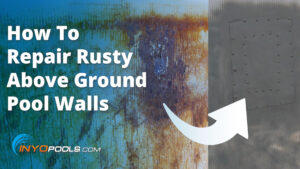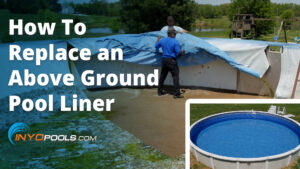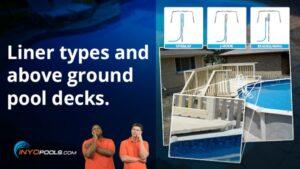An off-level above ground pool isn’t just an eyesore; it can lead to structural problems, water imbalance, and even potential safety risks. If your pool is uneven, it’s crucial to address the issue before it worsens. In this guide, we’ll show you how to Fix an Off-Level Above Ground Pool with practical tips to ensure your pool is stable, functional, and safe for years to come.
With the invention of YouTube, I have seen a lot of above ground pool installations done by do-it-yourselfers. I have also seen a lot of installation attempts as people call me halfway through for help. Some of these self-installations are done well, but most are not. I have occasionally been amazed at the ability of some to do a nice job on the not so easy job of building an above ground pool. Though, most really struggled with the project and barely got it together, lost friends and destroyed marriages.
So What Then Makes for a Poor Above Ground Pool Installation?

There are a number of ways an above ground can come out badly installed. The most common one is having wrinkles in the liner. Another is when the pool is misshapen or the uprights are not vertical. There is also equipment that leak and/or the skimmer and return fitting that is not tightly installed.
Another fairly common shortcoming do-it-yourselfers make is the groundwork. Pool bottoms can be “off level”, lumpy, “foot printy” (official term), rocky, and rough. Some bypass the very physically demanding, but necessary, step of removing the sod. They just lay down some sand on top of the grass for leveling and then build the pool. Big mistake!
All of the above mistakes in building an above ground pool are annoying and shouldn’t be accepted, if you are paying for an installation. However, to me the biggest indicator of a poorly built pool is when it is “off level”. Getting an above ground at least fairly level can be difficult, but it’s worth the effort. Here’s why:
Water Has to Be Level – It Has to Be!
Take a half-full (or half-empty depending on your life outlook) glass of water and tilt it. Notice that the glass becomes “off level”, but the water does not. Now take the glass and shake and swirl the water. Try to disrupt the water in any creative way you want and then tilt the glass again. That’s right. The water stays level regardless. This is because it is liquid and has a weight so the water will always distribute evenly against the pull of the earth or gravity. Did I overexplain? Sorry.
Now think of an above ground swimming pool as a giant glass of water. Tilt the pool and the water stays level. I know this sounds obvious, but it’s not to some. Many things that are built can be “off level” and some wouldn’t notice but something that holds water can’t get away with being too “off level”. This is why it’s kind of important to build a pool so that it is level.
How Level Does an Above Ground Pool Have to Be?
As a quality installer, I go through a lot to make my pools as level as I can. Above ground pools are not Swiss watches. There is nothing precise about them so it can be a challenge to get them close to perfectly level. Despite my high level of knowledge, fancy equipment, and strong desire to get the thing level, I’m happy to get my pools to within an eighth of an inch level. With oval shapes, I’m happy with a quarter of an inch off as they suck to install.
Most instruction manuals for above grounds are poor. If they do manage to tell you, they usually say to level the pool to within an inch. A pool being off by a full inch is OK and won’t cause any structural issues, but you may notice it is “off level” at its waterline. Remembering that water will always be level (see over-explanation above), your eye may pick up the difference between the perfectly level waterline against the “off level” liner that has a tile print.
Above Grounds That Are Too “Off Level”
Pools that are “off level” by more than an inch start to look tilted. If it’s two inches off, you can start to notice from the outside of the pool. It can be tough to tell sometimes if the yard is “off level”, but at two inches, the mind picks up the difference and you’ll know something is not right. Two inches off usually won’t cause any structural issues so you can (and a lot do) just live with your “off level” pool for years. If it’s off more than that though, there can be a problem.
Above grounds that are three inches off or more often don’t last. Not only does the thing look bad and sometimes it can be dangerous, the uneven wall creates extra outward pressure on one side. This extra pressure will eventually push the pool out of shape more and more and in extreme cases will cause the water to spill over and collapse the pool. Done.
Just to be clear, if your above ground pool is off by three inches or more, it needs to be taken down, leveled and reinstalled.
Can You Fix an “Off Level” Pool?

Usually severely “off level” pools have to be taken completely down, leveled properly, and then reinstalled. When this is done, you’ll have to spring for a new liner as they don’t like to be reused. Some of you will reuse the liner because you are cheap and stubborn, but it’s not the right way to do the fix. And that’s what probably got you to have to rebuild your pool in the first place. Just sayin’!
If the pool is off just a little more than it should be, you can level the wall without taking down the pool, but it’s not easy. Most seasoned pool installers don’t even know how to do this so keep that in mind.
Drain the pool (but not so that it is completely empty). Pull out the leveling blocks from under the uprights on the low side of the “off level” pool. Using a shovel, pry up the wall from each bottom connector to the desired level and reinstall the blocks. Repeat around the low side of the pool. Add and pack earth under where you have jacked up the wall. Refill the pool and hope you packed the earth well. Do not try to lower the high side of the pool. It’s too technical. Good luck!












Leave a Reply